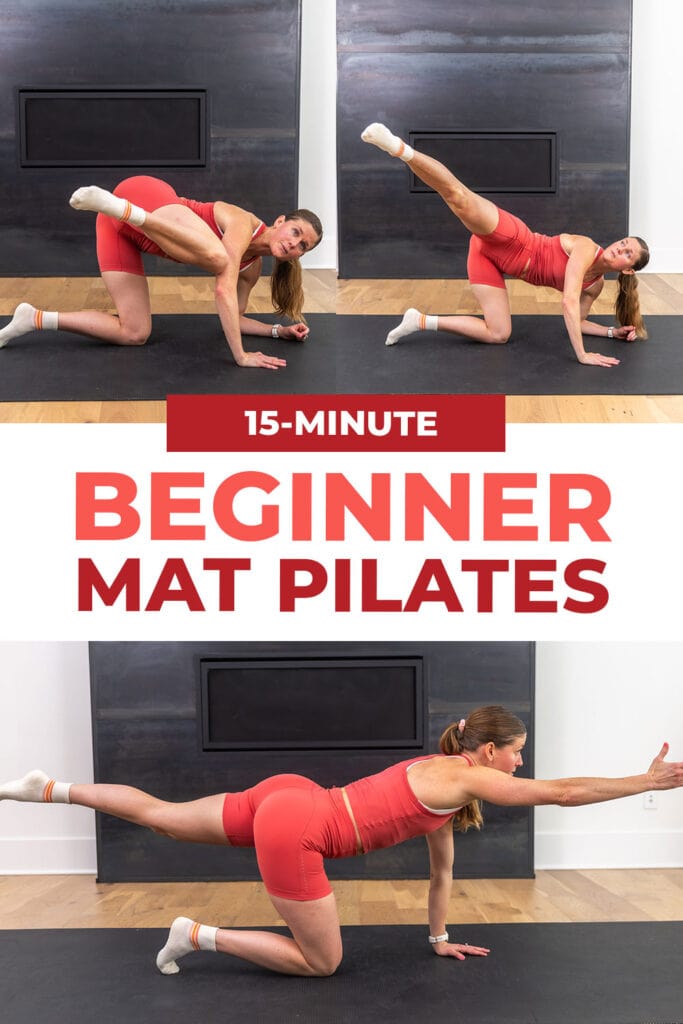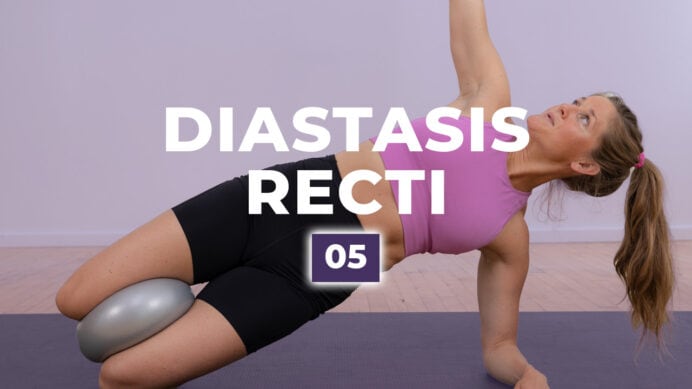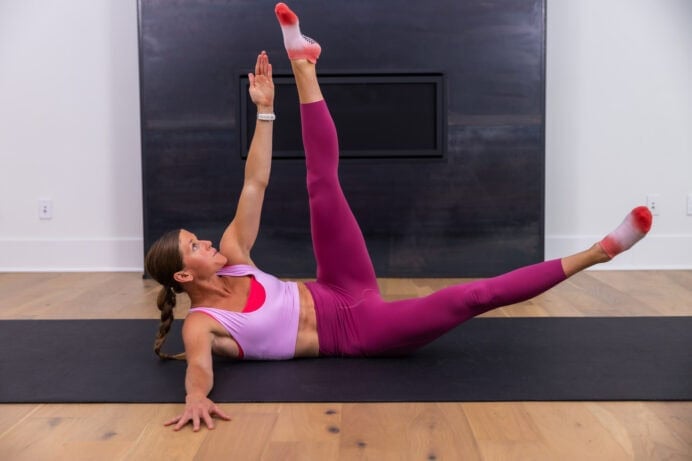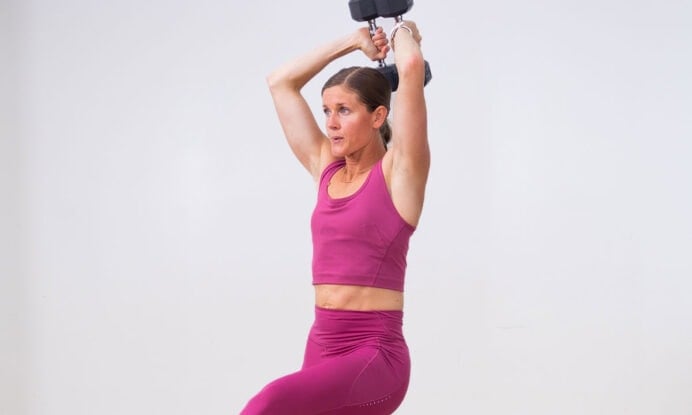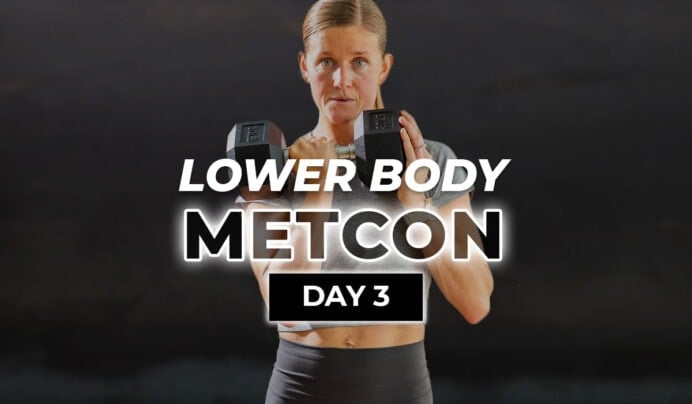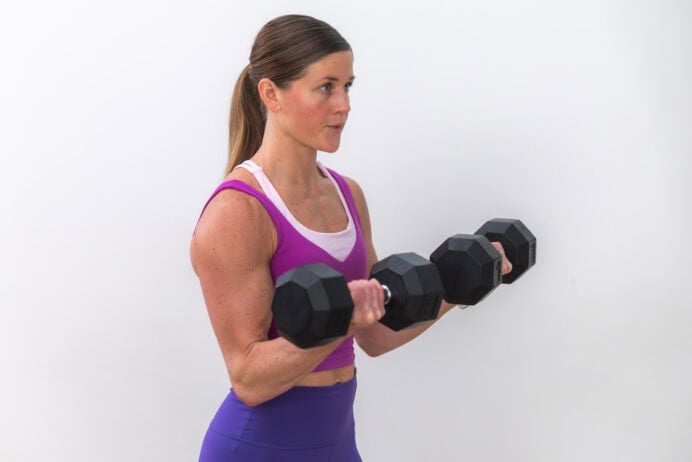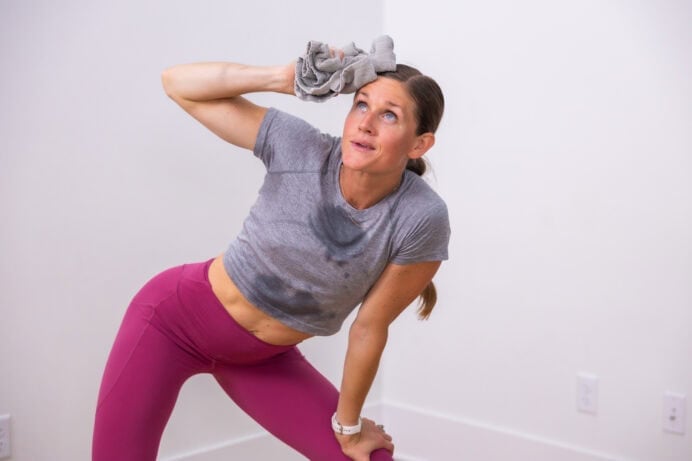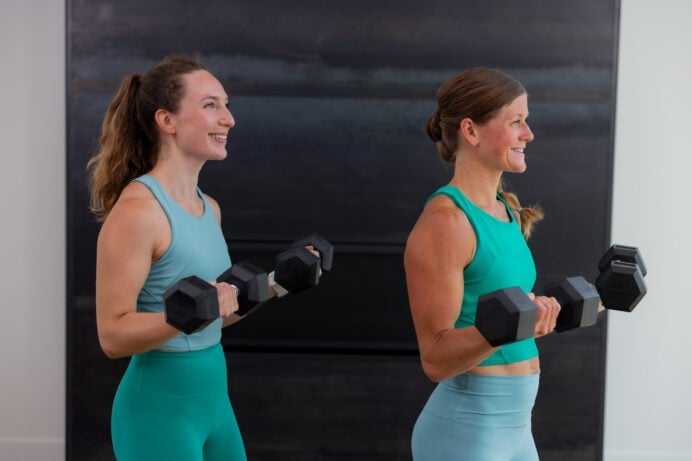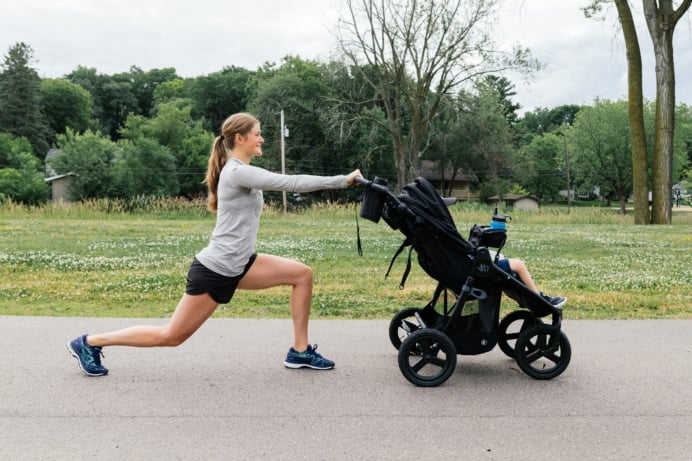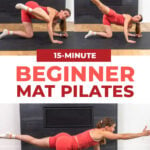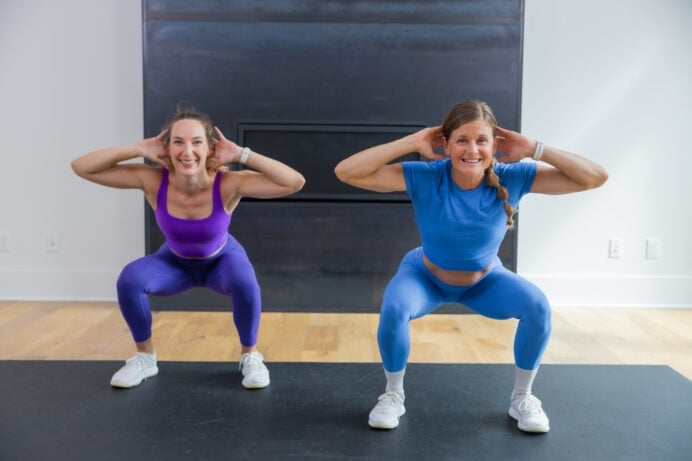
15-Minute Beginner Pilates
Build foundational strength, stability and control with this no-equipment mat pilates workout for beginners. This full-body, beginner-friendly pilates routine will make you feel strong and energized in just 15 minutes. Bonus: no need to travel in-person to an expensive pilates studio – you can do this pilates video at home using just your bodyweight.
Whether you’re new to working out, a strength-training-lover or a runner looking to branch out into a new type of workout, this beginner pilates workout is a great place to start.
You may know me as more of a strength-training instructor now, but I spent years teaching barre pilates and pilates HIIT classes at local boutique studios here in Minnesota.
Pilates is a type of workout developed by Joseph Pilates, a German physical therapist and gymnast, in the early 1900s as a way of helping people recover from injuries. It focuses on core strength, posture, mobility and intentional, controlled movements. Pilates workouts tend to be low-impact and gentle on the joints, making them ideal for beginners, pregnancy/postpartum, and anyone recovering from injury.
In my opinion, pilates is a great workout for beginners to start with because it’s low-impact, requires minimal equipment and teaches the importance of breathwork and mind-muscle connection. If you’re brand new to working out, pilates is a low-risk method of starting a fitness routine.
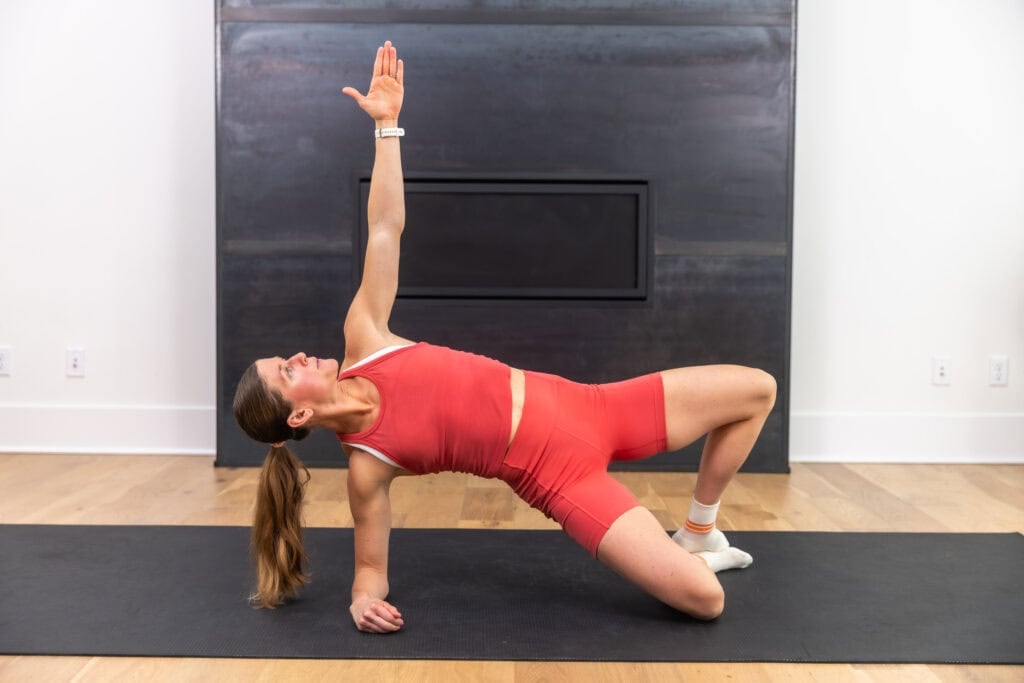
I personally love using at-home pilates workouts as a way to complement my heavy strength-training sessions during the week.
The light-weight, high-volume style of lifting found in pilates workouts is especially effective at targeting the smaller stabilizing muscles in the core, thighs and shoulders. I also think pilates is one of the most effective abs workouts you can do, because it focuses on building core stability from all angles.
Although pilates is commonly marketed as a way to “tone” muscles, its benefits are much more functional. Practicing pilates can improve your body awareness, build deep core strength, increase flexibility and mobility, improve posture and strengthen the small stabilizing muscles surrounding your joints.
There are 2 main types of pilates: mat pilates and reformer pilates. If you’re a beginner, I recommend starting with mat pilates workouts like this one to learn the fundamentals and proper form before progressing to pilates classes with specialized equipment.
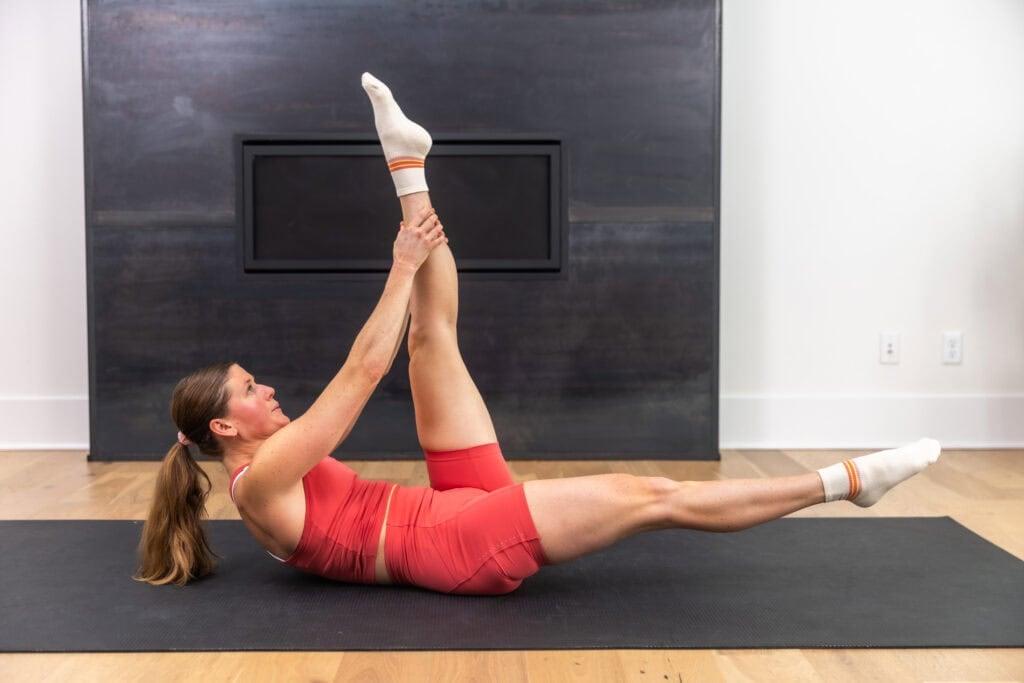
Workout Insights
Build strength, stability, confidence and lean muscle with this beginner pilates workout. I’ll coach you through a brief warm-up, then we’ll jump into this full-body mat pilates workout video.
I recommend adding pilates workouts like this one to your weekly workout routine or beginner workout plan 1-2 times a week.
Workout Equipment
No equipment needed for this bodyweight-only, mat pilates workout.
Workout Instructions
Follow along with the guided full video: Full-Body Pilates Workout on my YouTube Channel, led by me — your certified barre/pilates instructor, Lindsey Bomgren.
Your Workout Looks Like This:
- 9 Beginner Pilates Exercises
- Guided flow (spending approximately 60-90 seconds on each exercise before moving on to the next)
- Perform Each Exercise x1 Set (No Repeat)
Workout Outline
Screenshot or Pin this Workout:

1. Bird Dog Lift Off
Targets: Erector spinae, glutes, hamstrings, shoulders and abs.
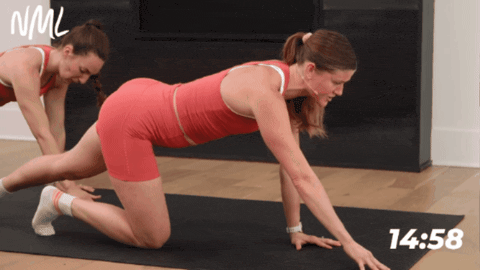
How to Do a Bird Dog Lift Off
- Find a quadruped position with your knees hip-width apart and hands firmly on the ground, about shoulder-width apart. Engage your core by pulling your belly button to your spine.
- Find a bird dog position by extending your right leg back, floating it off the ground. As you extend the right leg back, extend the opposite arm (left arm) straight out in front of you.
- Hold the right leg back and left arm out for a moment, then return to the starting position on all fours.
2. Down Dog to Push-Up
Targets: Chest, shoulders, triceps, back, hamstrings, hip flexors, calves, ankles, abs and core.
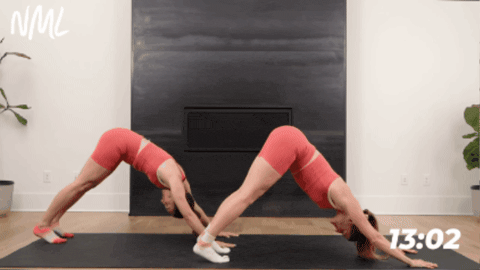
How to Do a Down Dog to Push-Up
- Start in a tabletop position (quadruped) on all fours; shoulders stacked over wrists and hips stacked over knees.
- As you exhale, lift your knees off the mat and straighten your legs as you press your hips up towards the ceiling to find downward-facing dog pose. Press evenly through your fingers, pushing your chest towards your thighs.
- Then shift your weight forward into a high plank position with your shoulders stacked over your wrists, weight evenly distributed amongst all 10 fingers.
- Hold this plank position, maintaining a straight line with your body, gaze slightly in front of you.
- Slowly lower your chest down towards the ground as your elbows fall back towards your hips.
- Once at the bottom of your push-up, exhale as you push back up into high plank position, then press your hips back to return to down dog.
Modification: If push-ups hurt your wrists, check out these modifications for wrist pain. If you want to scale up to a full push-up, start with one of these push-up variations.
3. Seesaw Forearm Plank
Targets: Upper abs, lower abs, obliques, shoulders, glutes and thighs.
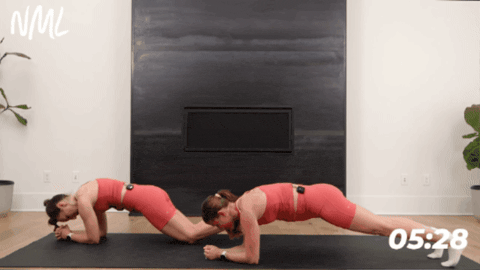
How to Do a Seesaw Forearm Plank
- Start on all fours, then lower your forearms to the floor. Your elbows should be directly under your shoulders.
- Step your feet back so your body forms a straight line from head to heels. Engage your deep core by pulling your belly button in towards your spine.
- Then, rock forward, shifting to press your nose over your fingertips. Focus on keeping your hips even, avoiding any piking or sagging.
- With control, reverse the motion, rocking back so your shoulders are stacked over your elbows.
4. Fire Hydrant Lift and Leg Extension
Targets: Gluteus maximus, hip abductors and core.
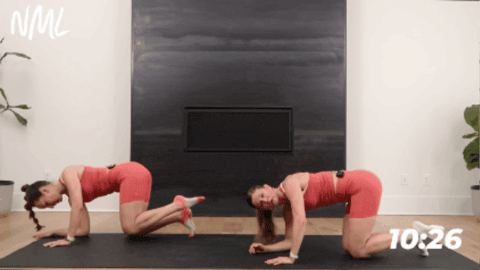
How to Do a Fire Hydrant Lift and Leg Extension
- Start in a tabletop position, quadruped on all fours, shoulders stacked over wrists and hips stacked over knees. Option to drop your left forearm to the mat for more stability.
- Maintaining a 90-degree bend in your right knee, lift your right leg up and to the side so your right knee is in line with your right hip.
- Then, straighten your right leg, kicking your right toes out at a diagonal away from your body.
- With control, reverse the motion, pulling your toes in, bending your right knee and lowering it to the ground, returning to the starting position.
5. Tabletop Oblique Crunch
Targets: Obliques, hips, shoulders, outer glutes and core.
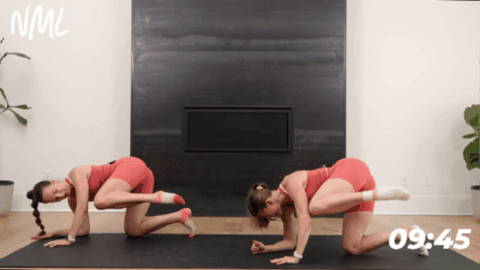
How to Do Tabletop Oblique Crunches
- Start in a tabletop position, quadruped on all fours, shoulders stacked over wrists and hips stacked over knees. Option to drop your left forearm to the mat for more stability.
- Extend your right leg behind you, squeezing your right glutes to lift your leg.
- On an exhale, pull your right knee in towards your right tricep, crunching through the sides of your torso (your obliques) to pull your knee in.
6. Pilates Hundreds
Targets: Deep core muscles (transverse abdominis), lower abdominal muscles and rectus abdominis muscles.
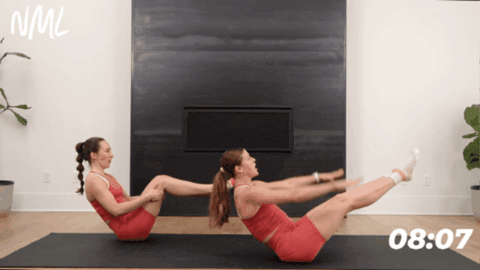
How to Do a Pilates Hundreds Exercise
- Start sitting on the floor with your legs bent at 90 degrees. Lean back slightly, sitting on your sit bones (two sitting bones and tailbone), keeping a nice long spine, shoulders down and back.
- Place your hands behind your knees and lift your feet off the ground. Bent legs are extended out in front of you.
- If possible, slowly straighten your legs out in front of you. Raise the tips of your toes to eye-level or just higher.
- Then straighten your arms, extending them out at shoulder height, palms facing down. Pulse your arms up and down 2-3 inches, while holding this position (pilates hundreds or boat pose).
7. Modified Side Plank Reach and Clamshell
Targets: Gluteus medius, gluteus minimus, internal and external obliques, transverse abdominus and core.
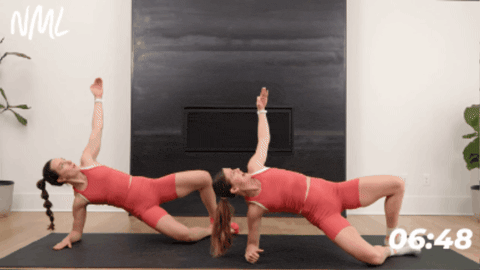
How to Do a Modified Side Plank Reach and Clamshell
- Start in a modified side plank or knee-down side plank. Lay on your right side, with your right forearm on the mat and right shoulder stacked over right elbow. Your legs should be stacked and knees bent at a 45-degree angle so your feet are slightly behind you.
- Keeping your core engaged, reach your left arm underneath your body, rotating your shoulders towards the mat as you tap the ground underneath your right shoulder.
- Inhale as you reverse the motion, opening your chest up as you sweep your left arm towards the ceiling. As you reach overhead, open your left knee up towards the ceiling, mimicking a clamshell opening.
- With control, close your legs and lower your left arm, returning to the starting position.
8. Single Leg Glute Bridge Leg Lift
Targets: Glutes, hamstrings, hips, core and pelvic floor.
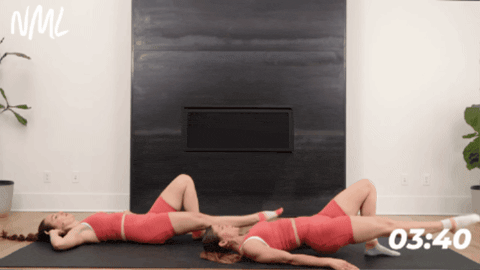
How to Do a Single Leg Glute Bridge Leg Lift
- Start lying on your back, feet hip-width apart, right foot planted on the floor and left foot extended straight overhead, toes pointed (ankle stacked over knee).
- Press through your heels to lift your glutes off the mat, squeezing your glutes as you lift. Think about keeping your core engaged, hips even and knees in line with your hips.
- Keeping your left leg straight, hold this glute bridge as you slowly lower your left leg towards the floor, hovering it an inch off the ground.
- Then, flex your left foot and sweep your left leg up, until the left ankle is stacked over the left hip, returning to the starting position.
9. Straight Leg Pull
Targets: Deep core muscles (transverse abdominis), lower abdominal muscles, and hip flexors.
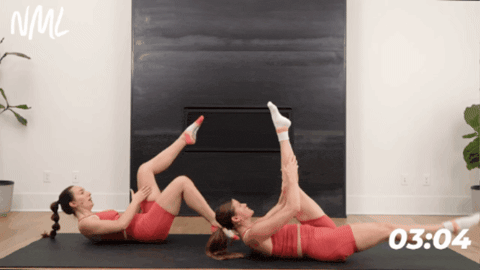
How to Do a Straight Leg Pull
- Lay flat on the floor, legs extended away from your body. Activate your core by pressing your lower back into the mat. Lift your neck and shoulders off the ground.
- Keeping both legs straight, hover your left heel off the ground and pull your right leg in towards your chest, catching it with both hands around your calf. Pulse your leg in for a two-count single leg stretch.
- Then switch, “scissoring” your legs as you pull the left leg in towards your chest and kick the right leg out, hovering the right heel off the ground. Pulse for a 2-count.
- Continue this pattern, alternating legs with each rep.
FAQs
I recommend beginners start with 2-3 pilates sessions a week. This frequency allows your body enough time to recover between sessions, builds consistency and helps develop a regular fitness routine and will lead to increased strength and definition.
You don’t need fancy equipment to get started with pilates. Mat pilates requires just your bodyweight and a pilates or yoga mat to cushion your spine, which makes it easy to do at home. As you progress, you may wish to add resistance bands, a pilates ball or light hand weights to increase the intensity.
Pilates exercises provide a low-impact way to build lean muscle and increase core strength, making them a good addition to any workout routine. However, pilates may not be as efficient in burning calories as HIIT cardio or strength and endurance training. If weight loss is the goal, try pairing a hybrid strength and pilates workout plan (such as the “3-2-8” method) with a healthy diet and deficit.
More Workouts
Barre/Pilates WorkoutsPin This Beginner Pilates Workout
